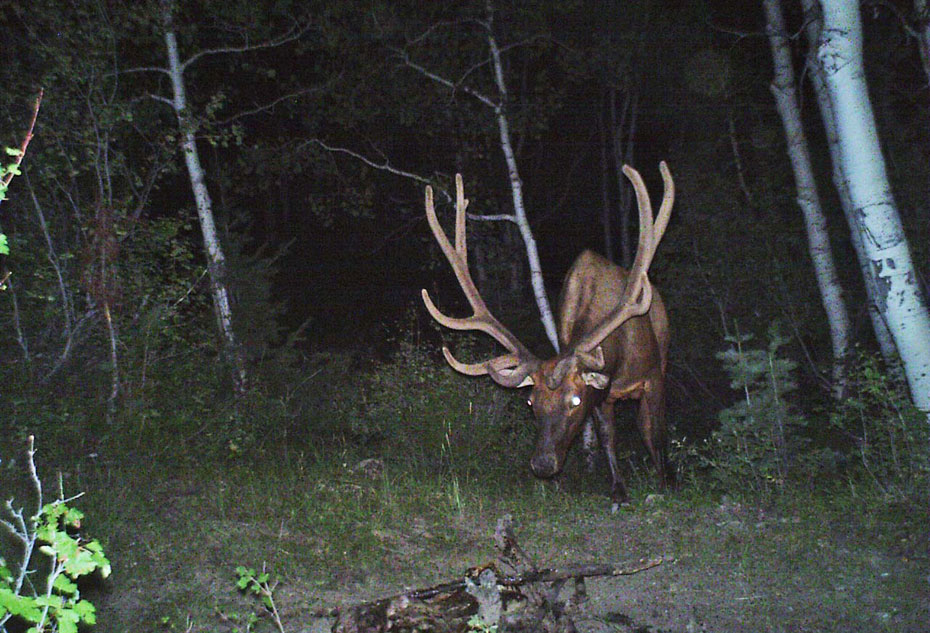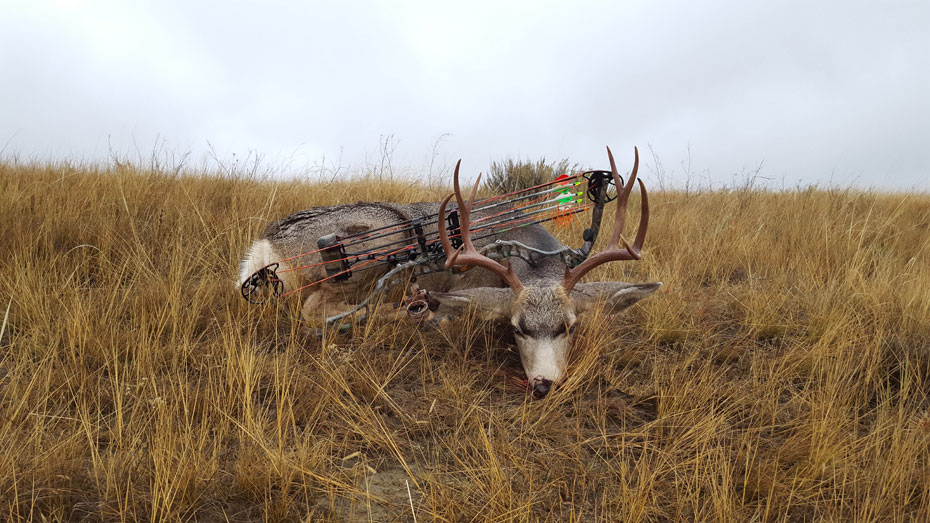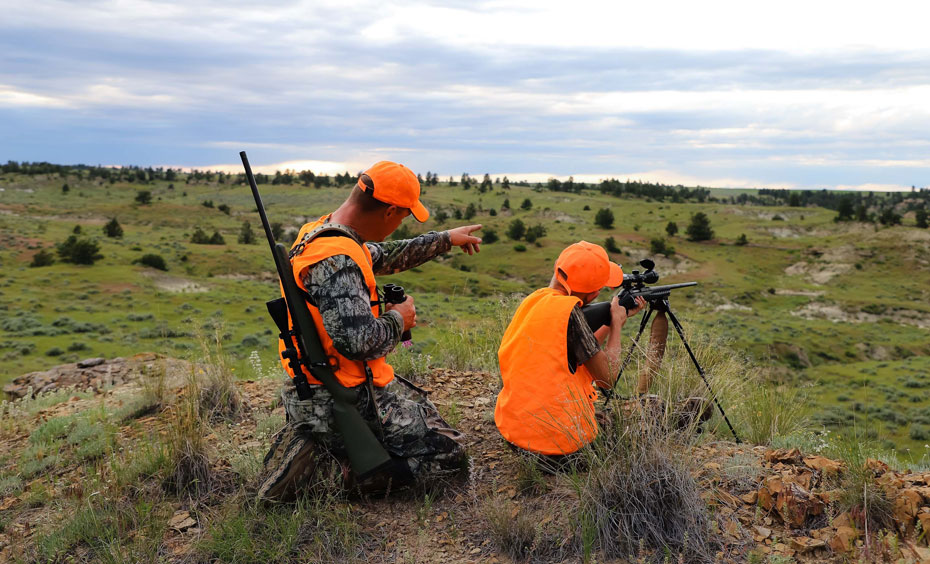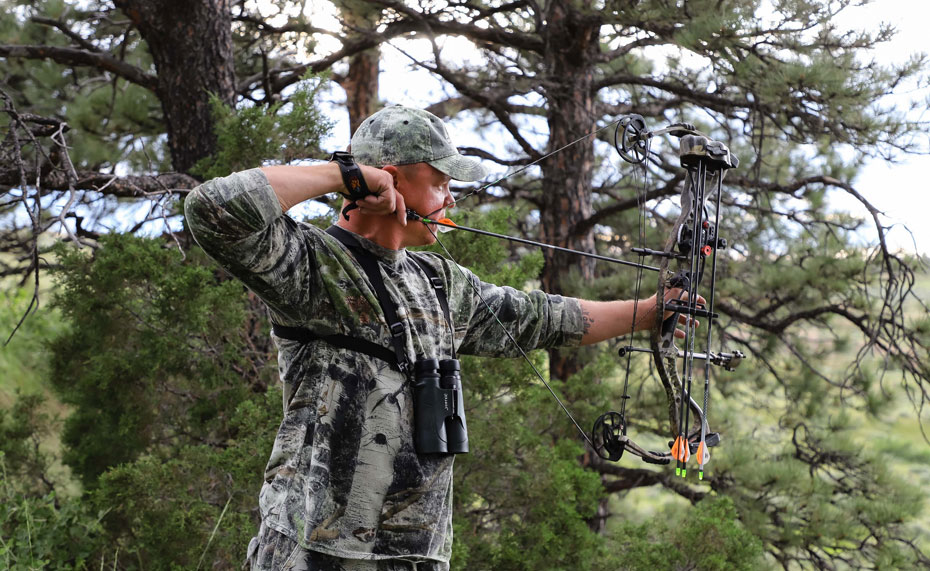Carl Frederickson of Billings, Montana, has been hunting Montana elk for seven years and is originally from Colorado where he hunted elk for 20 years.
“I’ve been hunting elk since I was 12-years old,” Frederickson said. “My parents and my grandparents also were elk hunters. I never stop getting ready for elk season.”
Scouting for Elk

As soon as elk season ends one year, I start planning for the next year’s elk season. I do much of my scouting in the summertime. I put out trail cameras and try to find my elk to hunt during the summer. I attempt to keep track of those elk until elk season starts. I hunt only public lands, and I usually walk about five miles in before I ever start scouting. Then I search for watering holes and game trails or any places I see any crossing fences. I’ve never had trouble finding elk, but it’s the taking aspect of elk hunting where I haven’t been as successful.
During the summer, the cows and the bulls stay separate. Then the first or second week in August, the bulls begin to rut and gather up their cows. Scouting for elk then becomes very different. In Montana, our elk season comes in the first Saturday of September. After the summer months end, we have to take down our trail cameras two weeks before elk season begins. I have to do a lot of walking and scouting after taking the cameras down. Elk generally will remain in the same areas where I’ve seen them in the summer, unless they’re moved out by hunting pressure. They usually hang out around water, because when archery season starts the temperatures are in the 80s and 90s.
During the first two weeks of archery season for elk, which I believe are the best two weeks to hunt, the weather is hot. Every few years or so, we may get a snow storm during that September time, but if we do, the snow may last only two or three days and then the temperatures will rise to the 70s or 80s. Bow season for elk runs from the first Saturday in September until the second Sunday of October. I usually chase a number of different bulls during our archery season. Bull elk more or less establish a home range until hunting pressure moves them out of that range.
Once I pull my trail cameras out of the regions where I’ve found elk, I don’t go back to those areas until the first day of archery season arrives. Then those elk aren’t receiving any pressure from me. Last year during the opening two days of elk archery season, I hiked 32 miles. Remember, I walk five miles in before I ever start hunting. When I chase elk, the elk will cover lots of country. My dad, my niece, my nephew and myself hunted opening weekend of the 2017 season. After the first day, my niece announced she’d had enough and wasn’t going elk hunting again. Many people like to cruise around public lands on four wheelers using public roads. However, all but one elk I’ve harvested, I’ve taken when hunting alone.
I generally quarter my elk after I’ve shot him and then take about five hours to get that elk out of the backcountry. The first trip to my truck, I take out the backstraps and the rib meat I have in my backpack and my bow. Then I return to my elk, take a front quarter and a hindquarter and carry them out to my truck. My last trip I take a hindquarter, the front quarter and the antlers back to my truck, and I’m done.
Hunting Colorado and Montana

I’ve taken four bulls and about 20 cows in my elk-hunting career. During the elk season, usually the first elk that comes within bow range, I harvest. My family, including my wife and my three children, and I eat quite a lot of elk, and I hunt elk primarily for meat. For my family, putting meat on the table is far more important than hanging antlers on the wall. We usually eat two – three elk per year. We get all the steaks and roasts we can from the elk we harvest, and whatever’s left we grind into burger. We do all our own meat processing. In our elk burger, I like to put about 10-percent beef fat. My children love to eat wild game, and elk is their favorite meat.
Each year I buy an elk cow tag and my Sportsman’s License allows me to take a cow or a bull, depending on which unit I’m hunting. This year in 2018, I’ve drawn a trophy unit, and I hope to take a nice trophy bull elk there. Montana only gives out 500 archery tags for this trophy elk unit, and 8700 archers put in for those tags.
I primarily hunt elk in the Missouri Breaks, Bureau of Land Management (BLM) land where there are hundreds of thousands of acres available for hunting. Water holes and wallows are the primary areas I hunt during those first two weeks of bow season for elk. Most people hunt either early in the mornings or late in the evenings for elk. But when I hunt elk, I hunt all day. I set up, glass to spot the elk and stalk to try to get into a position to take a shot. I usually take off work the entire first week of elk season to hunt. However, this year, I’ll only be hunting Fridays, Saturdays and Sundays, since I drew a Colorado mule deer tag, and it starts one week before Montana’s archery season.
I’ll be traveling back and forth between Montana and Colorado quite a bit. From Montana to where I hunt in Colorado is an 8-hour drive. Don’t forget that most of my mule deer hunting and elk hunting have been done in Colorado in years past. I know that land much better than I do the land in Montana. I know plenty of productive places to hunt mule deer and elk in Colorado, because I’m so familiar with that land. However, I only know of a couple of counties to hunt elk in Montana. I’ll probably hunt 10 days in Colorado, unless I get lucky and harvest my mule deer on opening day. If so, I’ll come back and spend the rest of hunting season in Montana.
I buy a Sportsman’s License in Montana, which includes a deer tag, an elk tag, a fishing license, an upland bird license, a small game license and a bear tag. My no. 1 go-to hunt every season is mule deer, since I’ve been hunting them my entire life. I absolutely love hunting mule deer. In Montana, when you draw a deer tag, you can take either a mule deer or a white-tailed deer. Most people don’t realize what big whitetails we have in Montana, mainly because most people who live in or visit Montana prefer to hunt mule deer.
Another critter that lives in Montana is a cross between a white-tailed deer and a mule deer. But having said that, I’ve also seen some 170-inch whitetails living in the areas we generally consider mule deer country up in the sagebrush and cedars. Last year I had an opportunity to take a 170-plus whitetail. I was stalking and chasing a mule deer that would score between 170-180 inches. I was about 200-300 yards from the mulie. I kept glassing him, as I stalked closer for a shot. Just as I went over a small rock ledge, there stood a 170-inch whitetail below me. He jumped up, and I actually fell down some rocks, since he scared me. I was only 10 feet from him when he bounded away. As the whitetail ran, the mule deer ran too, and I didn’t get either of them.
A Bureau of Land Management Hot Spot
My best bull elk to date, a 6x6, scored 286 inches. I took him just south of Craig, Colorado, near the Yellow Jacket Pass. I was hunting mule deer with a friend of mine from New Mexico. I’d taken a mule deer during Colorado’s archery season in this same spot where I planned to put my friend to give him a chance at a mule deer. My friend had come up during rifle season for mule deer. I knew there was a 186-inch mule deer in that region, because that buck had been running with the smaller mule deer I’d taken with my bow earlier in the year.
No one was hunting in this section. Everyone drove right past this place. We were in my friend’s vehicle, and I told him to pull over and park on the side of the county road. We watched 70-80 trucks drive right by our truck. My friend kept looking at me as though I were crazy. We were 10 yards above where a large group of tent camps were set up on Bureau of Land Management (BLM) land, and all the hunters in the tent camps drove past us to go to the nearby national forest to hunt.
I told my friend, “After all the other hunters have driven out of the tent camp area, we’re going to walk about 100 yards off the road and set up on a pile of rocks and glass. Those mule deer should come to us.”
I hadn’t planned to hunt that day, since I’d already taken my mule deer. I planned to guide my friend. But the night before the hunt, I told my buddy, “I’m going to buy an elk tag. If I don’t, we’ll surely see an elk in the morning, and I won’t be able to shoot him.”

After all the hunters left the BLM tent camps, we walked in the dark to the pile of rocks where I wanted us to sit and glass. Just as the sun started coming up, 50 head of elk came across the landscape in front of us. I picked out the biggest bull, and squeezed my trigger. But what made this hunt even better was that we were eating breakfast at a café before this where many of the elk hunters came to buy breakfast before they hunted. Some elk hunters from out of state sat close to us, all talking about their big-caliber rifles they were hunting with – mostly .300 Win Mags and their .700 ultra mags – ridiculously large calibers for elk hunting in my book.
When we got up to pay for our breakfasts, I went over to where the out-of-state hunters sat and told them, “Fellows, I heard y’all discussing those big-caliber elk guns you’re planning to shoot. But I’ve been hunting elk my entire life with a .270. I’ve taken numbers of elk, deer and bears with that gun.”
We talked for a few minutes. Finally I made a bet with these hunters that I’d harvest an elk on opening day with my .270. The bull I shot was 380 yards from the rock pile where we were set up, and he went down in the same tracks where he’d been standing. My buddy videoed the elk coming in, my getting ready for the shot, taking the shot, seeing the elk go down and me with my elk. The next morning, we returned to that same café, and those same guys were sitting at the same table as the day before. My buddy showed them the video of me taking the elk the day before, and I left the café a few hundred dollars richer than I’d been when I walked into the café.
I knew the country we’d been hunting very well, and I also knew the elk were holding in this little spot. This BLM land bordered private property. The elk would bed up during the day on that land, and then would come down to this small patch of quaking aspens to feed at night. So, there was food and water in this small patch of BLM land. Probably no more than 200 acres of BLM property were in that small section of land. I had taken my archery mule deer buck not 100 yards from where I took the bull elk. I had seen elk when I was hunting my mule deer. The year before I took the mule deer and the elk in this same general area, my brother had taken a 180-inch mule deer there. There’s so many mule deer and elk in this spot due to no one hunting there. The region where all the BLM tent campers stay is only 200- 300 yards from this place, but they can’t see this little place where the elk and the mule deer are.
The year before, my brother and I were driving up this county road in this region to go to the national forest when we saw the mule deer buck that my brother harvested later that year, coming out of this area. When we went in to find my brother’s mulie, we discovered the spring and numbers of elk and mule deer tracks there. We started hunting this spot and never saw another hunter.
The hunting season in Colorado is only 5-10 days long, so you get a new bunch of hunters each one of the elk seasons. They all park and camp on the BLM land and go up into the national forest to hunt. That’s another secret for finding a great place to take a nice elk – look for sections of land that no one will want to hunt. Oftentimes you’ll see elk living there.
Elk Hunting Capital of the World
My second-best bull elk was the first bull I ever harvested when I was only 19 years old in 2001 near Grand Lake, Colorado. A buddy and I went out on opening morning and didn’t see many elk. We were driving back to town when we spotted a herd of elk out in a farmer’s hay field. We stopped by the farmer’s house and asked if I could hunt the elk in his hayfield. One of those bulls in this herd was at least 350 points or better.
He told us, “You can take any elk you want out of that herd, except for that really big elk.”
I slipped into his property, walked down through a clump of trees to get away from the road and saw a 5x5 bull out in a hayfield, about 18 yards away, not paying any attention to me. I squeezed my trigger. When I went out into the field to recover my elk, the rest of the elk in the herd moved over to the edge of the field and watched me field dress the bull I’d taken and as I quartered the bull and carried him out. I was probably only 50 yards from that biggest bull at one time.
The property I hunted was next to Estes Park. I truly believe that the big bull came from Estes Park where some monster-sized bull elk and mule deer live. People can hunt in Estes Park, but that’s a highly coveted tag since few of those tags are given out. A hunter may have to apply for 30 years before getting a tag for an Estes Park hunt.
I was very fortunate that the landowner allowed me to come onto his property and take my first bull elk. Two types of landowners in Colorado have elk on their lands. Farmers who aren’t hunters want hunters to come on their properties and take all the elk they can, because the elk destroy their haystacks, break down their fences and eat their crops. They despise elk. Other landowners are all about making money from their elk herds, especially around Craig, Colorado, where just about everyone hunts. They want to lease their hunting rights. The population of Craig usually triples during hunting season. There’s actually a sign outside of Craig that says, “Welcome to Craig, Colorado, the Elk Hunting Capital of the World.”
A tremendous herd of elk live around Craig. I’ve seen as many as 2,000 elk in one herd there. Plenty of winter habitat for elk is down in the flat sagebrush where there’s also an abundance of food. Craig is completely surrounded by mountains, which means the elk can travel into the mountains and live there until the snow becomes too deep. The Black Mountain Area and the Freeman Reservoir in the Routt National Forest are in this region north of Craig. Hunters take a good number of elk in that vicinity. Colorado has numbers of elk, but the sizes of the bull elk in Montana seem to be better.
Elk Hunting Secrets

For the 2018 season, I’m planning to hunt mule deer in Colorado and Montana and hunt elk in Montana. I usually start the first of June going into the regions I plan to hunt during archery season, setting up my six trail cameras and checking them every Saturday. I generally see tons of elk, mule deer, antelopes and coyotes on the pictures. I decide to put the cameras in places after traveling two miles into where I’m planning to hunt. Those are the cameras I use to see if any other hunters are scouting the same regions I’m planning to hunt. Although I may get photos of game, those first two cameras are to target hunter movement. Only two trails are there that anyone who plans to get into the backcountry will use. The terrain there is tough – lots of rock faces, thick trees and hard climbs, if you don’t stay on the trail. Then I’ll set up the other four cameras where I expect to see elk. I’ll see bulls as small as spikes or that may score 380-plus inches in this region.
One of the advantages for hunting the place in Montana is I never see anyone else in that area. The property I’m hunting is BLM land right in-between two large pieces of private land. Too, this area is walk-in only. Not too many elk hunters like to walk long distances. I’ve actually had elk hunts ruined by nearby landowners riding their properties on four wheelers.
I prefer to hunt tiny spots where no one else wants to hunt elk. The land I hunt is only five square miles, and that’s not much land in elk country. I always look for walk-in only places that people on four wheelers will drive past, because they don’t want to walk in to hunt. So, another of my secrets for successful elk hunting is to start with walk-in areas, go further than most people will go, find private land adjacent to public land and hunt in that region.
Another secret is I go into my spot well before daylight. I generally don’t rely on a GPS. I stay on the trail until I get to where I want to go. However, anyone else who’s coming out here to hunt who doesn’t live in this state should buy a quality GPS. I bought my first GPS three years ago. Prior to that, I navigated with paper maps. Once I got my GPS and started using it, I thought to myself, “What the heck took me so long to get one of these.” I was amazed at the information I could get and what I could download on my GPS receiver. I use the Montana onX map, which is accurate up to 20 feet. I hunt from the ground and have never hunted from a tree stand.
This year I’ve been doing some scouting, and I believe the antler growth in Montana is down. Perhaps this is due to a super, super cold, wet spring or for some other reason the elk’s antlers just don’t seem to be as big as in the past.
Need some big game recipe ideas? Get John and Denise Phillips’ free cookbook, “Miz Denise’s Outdoor Cooking: More Than 35 Recipes for Elk and Mule Deer.”



























